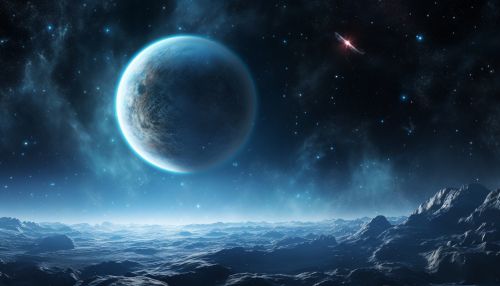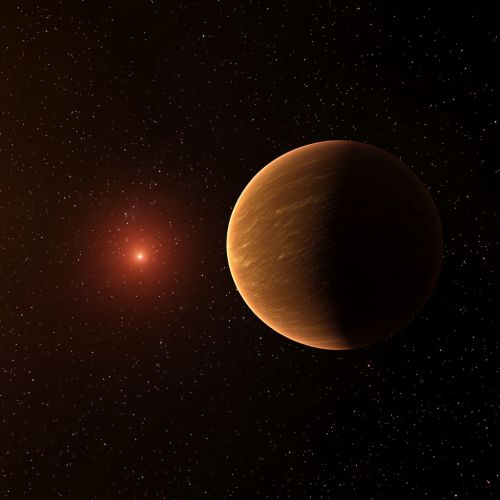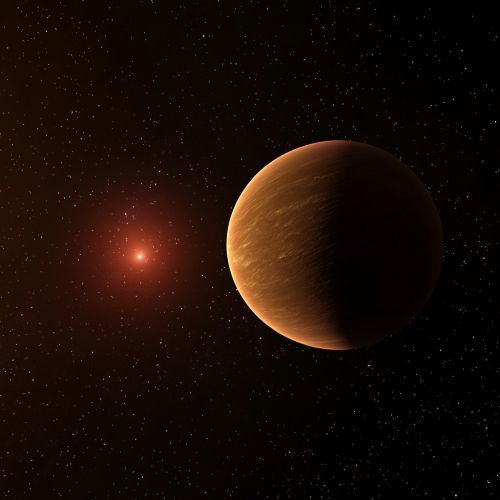Exoplanet
Introduction
An exoplanet, also known as an extrasolar planet, is a planet that orbits a star outside the solar system. The first scientific detection of an exoplanet was in 1988. However, the first confirmed detection came in 1992, with the discovery of several terrestrial-mass planets orbiting the pulsar PSR B1257+12. The first confirmation of an exoplanet orbiting a main-sequence star was made in 1995, when a giant planet was found in a four-day orbit around the nearby star 51 Pegasi.


Detection and Discovery
The study of exoplanets has been brought to the fore with the help of various spectroscopic methods. The radial velocity method, also known as Doppler spectroscopy, is the most effective method for locating extrasolar planets with existing technology. The main disadvantage of the radial velocity method is that it can only estimate a planet's minimum mass (== Introduction == The concept of minimum stellar mass is a fundamental aspect of astrophysics, defining the lower limit at which a celestial object can sustain hydrogen fusion in its core, thereby qualifying as a star. This threshold is critical for understanding the formation, evolution, and classification of stars within the broader context of stellar astrophysics.
Definition and Importance
The minimum stellar mass is the smallest mass a celestial object must have to initiate and sustain hydrogen fusion reactions in its core. This process is essential for a star to shine and produce energy over extended periods. Objects below this mass threshold are classified as brown dwarfs, which are substellar objects that cannot sustain hydrogen fusion.
Theoretical Background
The minimum mass for hydrogen fusion is approximately 0.08 solar masses (M☉), or about 80 times the mass of Jupiter. This value is derived from the principles of stellar structure and evolution, particularly the balance between gravitational forces and thermal pressure within a star.
Gravitational Contraction and Thermal Pressure
In the early stages of star formation, a protostar forms from the gravitational collapse of a molecular cloud. As the protostar contracts, its core temperature and pressure increase. When the core temperature reaches around 10 million Kelvin, hydrogen nuclei can overcome their electrostatic repulsion and fuse, releasing energy.
Degeneracy Pressure
For objects with masses below the minimum stellar mass, degeneracy pressure, a quantum mechanical effect, halts further gravitational contraction before the core temperature becomes high enough for hydrogen fusion. This results in the formation of a brown dwarf rather than a true star.
Observational Evidence
Observational data from various telescopes and space missions have provided empirical evidence supporting the theoretical minimum stellar mass. These observations include the detection of brown dwarfs and low-mass stars in star-forming regions and stellar clusters.


Brown Dwarfs
Brown dwarfs are substellar objects with masses between approximately 13 and 80 Jupiter masses. They occupy the mass range between the heaviest gas giant planets and the lightest stars. Brown dwarfs are characterized by their inability to sustain hydrogen fusion, although they may fuse deuterium or lithium in their early stages.
Formation and Characteristics
Brown dwarfs form similarly to stars, through the collapse of a molecular cloud fragment. However, their lower mass means they do not reach the necessary core temperatures for sustained hydrogen fusion. Brown dwarfs cool and fade over time, emitting primarily in the infrared spectrum.
Spectral Classification
Brown dwarfs are classified into spectral types L, T, and Y, based on their temperature and spectral features. These spectral types help astronomers distinguish brown dwarfs from low-mass stars and giant planets.
Implications for Stellar Evolution
The minimum stellar mass has significant implications for our understanding of stellar evolution and the initial mass function (IMF), which describes the distribution of masses for a population of stars at birth.
Initial Mass Function (IMF)
The IMF is a crucial tool in astrophysics, influencing theories on star formation rates, the chemical evolution of galaxies, and the dynamics of stellar populations. The minimum stellar mass sets a lower boundary for the IMF, impacting the relative numbers of low-mass stars and brown dwarfs.
Star Formation Theories
The process of star formation is influenced by the minimum stellar mass, as it determines the conditions under which a collapsing molecular cloud fragment can form a star. This threshold affects the efficiency of star formation and the resulting stellar population in a given region.
Conclusion
The concept of minimum stellar mass is essential for understanding the boundary between stars and substellar objects. It provides insights into the processes of star formation, the characteristics of brown dwarfs, and the broader implications for stellar evolution and the initial mass function. Continued observational and theoretical research in this area will further refine our knowledge of these fundamental astrophysical phenomena.
See Also
- Stellar Evolution
- Brown Dwarf
- Initial Mass Function). The radial-velocity method measures variations in the velocity of the central star, due to the changing direction of the gravitational pull from an (unseen) exoplanet as it orbits the star.
Characteristics of Exoplanets
Exoplanets are extremely diverse in their characteristics, with a wide range of masses, sizes, and orbits. They range from gas giants larger than Jupiter to small, rocky planets about the size of Earth or the Moon. Some exoplanets orbit extremely close to their stars, with periods of only a few hours, while others may be located at a distance greater than that of Neptune from the Sun.
Habitability
The potential habitability of exoplanets is a complex issue. While the discovery of Earth-like planets in the habitable zone has sparked interest, the habitability of these planets depends on a wide range of factors. These include the planet's distance from its star, its size, its geological activity, its atmosphere, and the nature of its star.
Future of Exoplanet Research
The future of exoplanet research is promising, with new technologies and missions planned for the coming decades. The James Webb Space Telescope, set to launch in 2021, will be capable of observing exoplanets in unprecedented detail. Other planned missions, such as the PLATO spacecraft, aim to detect and study Earth-like planets around Sun-like stars.
